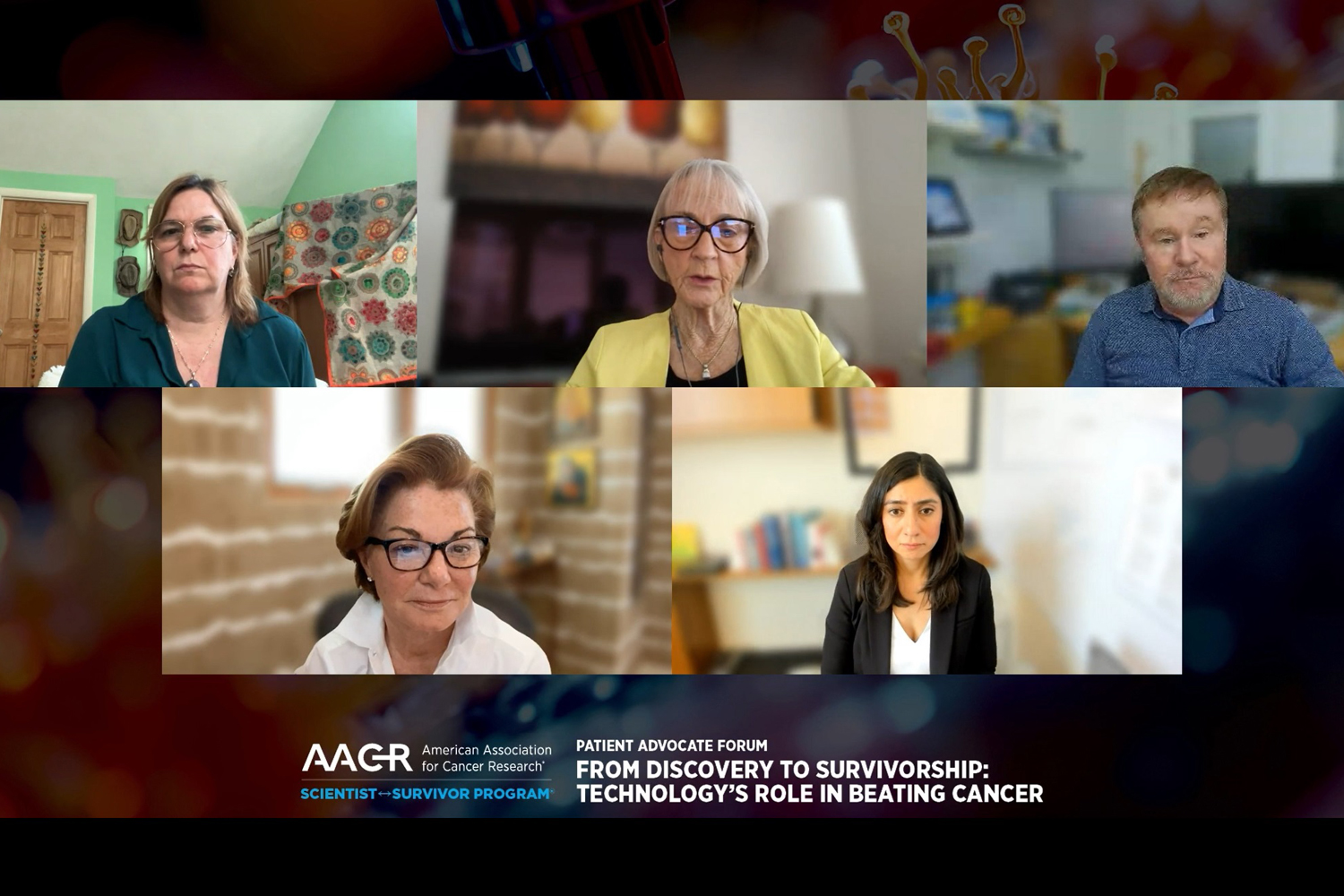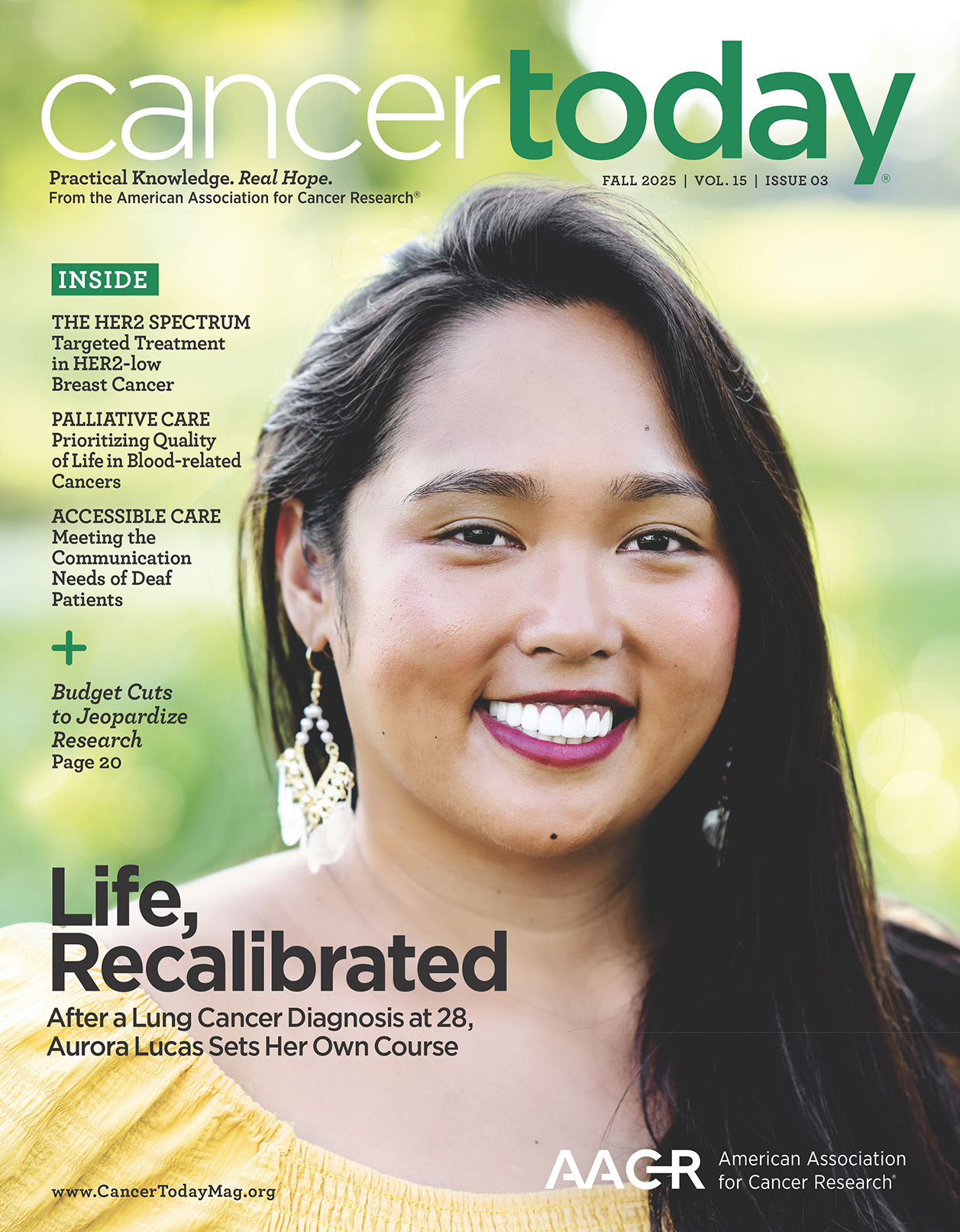IN THE PAST YEAR, artificial intelligence (AI) has dominated headlines, and pundits have predicted the technology will revolutionize all aspects of life, including medicine. But what does that mean for people diagnosed with cancer?
AI and other emerging technologies can help patients receive more efficient and effective cancer care, which could help lead to better quality of life, according to a panel of experts who participated in a July 15, 2025, Virtual Patient Advocate Forum, held by the American Association for Cancer Research (AACR). (The AACR also publishes Cancer Today.) The forum, titled “From Discovery to Survivorship: Technology’s Role in Beating Cancer,” focused on technologies that are rapidly progressing from concept to reality in clinical care.
“This is the science fiction of old, but this is what we are dealing with now in the present,” said forum moderator Anna Barker, chief strategy officer of the Ellison Medical Institute in Los Angeles.
AI Analytics
AI uses large computer models to perform human functions, such as thinking, learning and solving problems. But unlike humans, these models can analyze a seemingly infinite amount of data, allowing AI to reach conclusions based on more data than a human could possibly comprehend.
This ability to quickly synthesize data could dramatically accelerate cancer research. For example, Mayo Clinic has developed a database that contains records for 56 million people across the world and uses AI to see patterns in this real-world data, according to Cheryl L. Willman, director of the Mayo Clinic Comprehensive Cancer Center in Rochester, Minnesota.
Additionally, AI can help translate data into easy-to-understand language. Garry Nolan, an immunologist at Stanford University School of Medicine in California and a skin and kidney cancer survivor, helped develop an AI model that acts as a trained immunologist. Users can ask the program questions, and it will draw on data from more than 22 million scientific papers to offer an answer in natural language. Nolan said this technology allows everyone to easily access and understand the wealth of scientific information that’s available. “This democratizes the analysis that used to be only singularly available in certain laboratories,” he said.
Read our coverage of previous AACR Patient Advocate Forums.
AI could also lead to earlier cancer detection. After a patient has a CT scan, MRI or other imaging test, AI tools can quickly scan and detect patterns not visible to the human eye. “Our improved imaging tools, along with AI-based image analysis that helps radiologists review images, lead to faster, more accurate diagnoses so that we can initiate treatment quickly,” said Reva K. Basho, chief medical officer of the Ellison Medical Institute.
With AI tools, oncologists could potentially catch cancer years earlier than traditional techniques. One AI model can review patient records and detect pancreatic cancer up to three years before the human eye would spot it on a CT scan, according to Willman. In a clinical trial that is enrolling 10,000 people, Mayo Clinic plans to use the algorithm to identify those at high risk for pancreatic cancer and then monitor them with regular CT scans.
Additionally, AI could also speed up drug development. Researchers use AI tools to design drugs and identify the treatments most likely to be effective against a specific disease. One such tool is AlphaFold, an AI program that predicts the structure of proteins produced by cancer cells. Once researchers know what these structures look like, they can create molecules that bind to those proteins. This eliminates much of the trial-and-error process of isolating molecules that can delay drug development. “It’s put us on the highway of drug discovery,” Basho said.
Despite all of AI’s potential benefits, people still need to exercise caution, the experts warned. AI models only work if they are trained with adequate data that include all patient populations, according to Basho. AI can still sometimes present incorrect information, called a hallucination, but models are increasingly becoming more accurate, according to Nolan.
Oncologists also need to ensure they use the AI data properly, Basho said. AI can cause information overload, so oncologists need to put the data in context. Another potential pitfall is overdiagnosis. Improved early detection could lead to diagnoses of disease that never would have impacted the patient or for which no treatments exist.
Nanotechnology
While some presenters described how AI synthesizes massive amounts of data, Angela M. Belcher, a biological and materials engineer at the Massachusetts Institute of Technology in Cambridge, focused on the smallest bits of information. Nanotechnology deals with materials that are up to 100 nanometers in size—which is about a one-thousandth the thickness of a sheet of paper.
Belcher is exploring how nanotechnology can improve detection of ovarian cancer, which is often found in the fallopian tubes. When a person at risk for cancer has their fallopian tubes removed, pathologists examine slices of tissue from the fallopian tubes for cancerous cells. This, however, means only about 1% of the organ is inspected. Researchers have built a machine that uses nanoparticles designed to give off a bright light when a laser is shined on them. In an ongoing study, Belcher’s lab has used this machine to examine fallopian tubes from 87 people, rapidly scanning the entire organ instead of just a small sliver. They watch to see if the light produces optical signatures that indicate the presence of a tumor less than a millimeter in size, which would otherwise go unnoticed by standard pathology.
Decentralized Care and Clinical Trials
New technologies also hold the potential to bring cancer care right into a patient’s home. Mayo Clinic’s Cancer Care Beyond Walls program lets people with cancer receive chemotherapy without a trip to the clinic, according to Willman. Home health care professionals administer chemotherapy drugs in a patient’s home, and digital tools allow doctors to monitor the patient. Earlier this year, Mayo partnered with Altru Health System to offer the program in the Grand Forks, North Dakota, area. “It’s truly transformative in bringing access to high-quality cancer care to the home environment,” Willman said.
Virtual tools also could expand clinical trial access. Participants now can sign trial consent documents virtually, interact with the study team remotely and receive the investigational medication via home delivery. Researchers can monitor them via wearable technology, such as a smartwatch. Roughly a quarter of Mayo’s clinical trials—including 378 cancer studies—are now decentralized, meaning some or all of the trial activities occur outside of a traditional research hospital, according to Willman.
These programs eliminate the need for frequent hospital visits and long-distance travel, and they allow people who live far away from a cancer center to join a clinical trial. “Through these programs … we truly believe we look to a future where care can truly be accessible to all,” Willman said.
Cancer Today magazine is free to cancer patients, survivors and caregivers who live in the U.S. Subscribe here to receive four issues per year.





